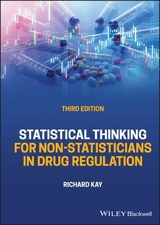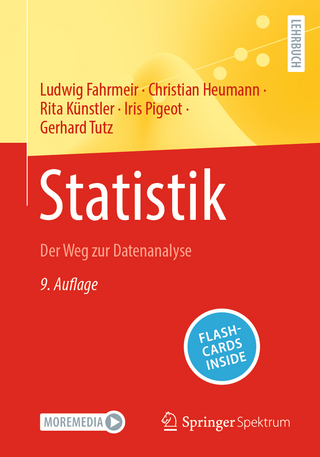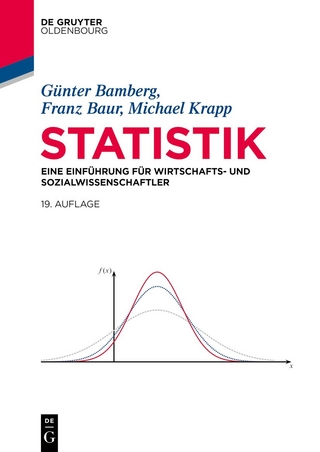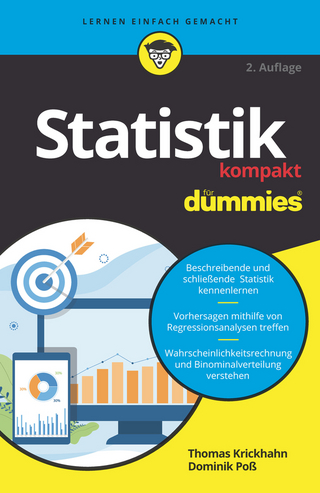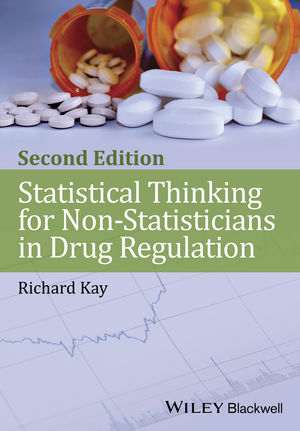
Statistical Thinking for Non–Statisticians in Drug Regulation
John Wiley & Sons Inc (Verlag)
978-1-118-47094-7 (ISBN)
- Titel ist leider vergriffen;
keine Neuauflage - Artikel merken
Statistical Thinking for Non-Statisticians in Drug Regulation, Second Edition, is a need-to-know guide to understanding statistical methodology, statistical data and results within drug development and clinical trials. It provides non-statisticians working in the pharmaceutical and medical device industries with an accessible introduction to the knowledge they need when working with statistical information and communicating with statisticians. It covers the statistical aspects of design, conduct, analysis and presentation of data from clinical trials in drug regulation and improves the ability to read, understand and critically appraise statistical methodology in papers and reports. As such, it is directly concerned with the day-to-day practice and the regulatory requirements of drug development and clinical trials. Fully conversant with current regulatory requirements, this second edition includes five new chapters covering Bayesian statistics, adaptive designs, observational studies, methods for safety analysis and monitoring and statistics for diagnosis.
Authored by a respected lecturer and consultant to the pharmaceutical industry, Statistical Thinking for Non-Statisticians in Drug Regulation is an ideal guide for physicians, clinical research scientists, managers and associates, data managers, medical writers, regulatory personnel and for all non-statisticians working and learning within the pharmaceutical industry.
Richard Kay, Consultant in Statistics for the Pharmaceutical Industry, Great Longstone, Derbyshire, UK
Preface to the second edition xv Preface to the first edition xvii Abbreviations xxi 1 Basic ideas in clinical trial design 1 1.1 Historical perspective 1 1.2 Control groups 2 1.3 Placebos and blinding 3 1.4 Randomisation 3 1.5 Bias and precision 9 1.6 Between- and within-patient designs 11 1.7 Crossover trials 12 1.8 Signal noise and evidence 13 1.9 Confirmatory and exploratory trials 15 1.10 Superiority equivalence and non-inferiority trials 16 1.11 Data and endpoint types 17 1.12 Choice of endpoint 18 2 Sampling and inferential statistics 23 2.1 Sample and population 23 2.2 Sample statistics and population parameters 24 2.3 The normal distribution 28 2.4 Sampling and the standard error of the mean 31 2.5 Standard errors more generally 34 3 Confidence intervals and p-values 38 3.1 Confidence intervals for a single mean 38 3.2 Confidence interval for other parameters 42 3.3 Hypothesis testing 45 4 Tests for simple treatment comparisons 56 4.1 The unpaired t-test 56 4.2 The paired t-test 57 4.3 Interpreting the t-tests 60 4.4 The chi-square test for binary data 61 4.5 Measures of treatment benefit 64 4.6 Fisher s exact test 69 4.7 Tests for categorical and ordinal data 71 4.8 Extensions for multiple treatment groups 75 5 Adjusting the analysis 78 5.1 Objectives for adjusted analysis 78 5.2 Comparing treatments for continuous data 78 5.3 Least squares means 82 5.4 Evaluating the homogeneity of the treatment effect 83 5.5 Methods for binary categorical and ordinal data 86 5.6 Multi-centre trials 87 6 Regression and analysis of covariance 89 6.1 Adjusting for baseline factors 89 6.2 Simple linear regression 89 6.3 Multiple regression 91 6.4 Logistic regression 94 6.5 Analysis of covariance for continuous data 94 6.6 Binary categorical and ordinal data 101 6.7 Regulatory aspects of the use of covariates 103 6.8 Baseline testing 105 7 Intention-to-treat and analysis sets 107 7.1 The principle of intention-to-treat 107 7.2 The practice of intention-to-treat 110 7.3 Missing data 113 7.4 Intention-to-treat and time-to-event data 118 7.5 General questions and considerations 120 8 Power and sample size 123 8.1 Type I and type II errors 123 8.2 Power 124 8.3 Calculating sample size 127 8.4 Impact of changing the parameters 130 8.5 Regulatory aspects 132 8.6 Reporting the sample size calculation 134 9 Statistical significance and clinical importance 136 9.1 Link between p-values and Confidence intervals 136 9.2 Confidence intervals for clinical importance 137 9.3 Misinterpretation of the p-value 139 9.4 Single pivotal trial and 0.05 140 10 Multiple testing 142 10.1 Inflation of the type I error 142 10.2 How does multiplicity arise? 143 10.3 Regulatory view 144 10.4 Multiple primary endpoints 145 10.5 Methods for adjustment 149 10.6 Multiple comparisons 152 10.7 Repeated evaluation over time 153 10.8 Subgroup testing 154 10.9 Other areas for multiplicity 156 11 Non-parametric and related methods 158 11.1 Assumptions underlying the t-tests and their extensions 158 11.2 Homogeneity of variance 158 11.3 The assumption of normality 159 11.4 Non-normality and transformations 161 11.5 Non-parametric tests 164 11.6 Advantages and disadvantages of non-parametric methods 168 11.7 Outliers 169 12 Equivalence and non-inferiority 170 12.1 Demonstrating similarity 170 12.2 Confidence intervals for equivalence 172 12.3 Confidence intervals for non-inferiority 173 12.4 A p-value approach 174 12.5 Assay sensitivity 176 12.6 Analysis sets 178 12.7 The choice of 179 12.8 Biocreep and constancy 184 12.9 Sample size calculations 184 12.10 Switching between non-inferiority and superiority 186 13 The analysis of survival data 189 13.1 Time-to-event data and censoring 189 13.2 Kaplan-Meier curves 190 13.3 Treatment comparisons 193 13.4 The hazard ratio 196 13.5 Adjusted analyses 199 13.6 Independent censoring 202 13.7 Sample size calculations 203 14 Interim analysis and data monitoring committees 205 14.1 Stopping rules for interim analysis 205 14.2 Stopping for efficacy and futility 206 14.3 Monitoring safety 210 14.4 Data monitoring committees 211 15 Bayesian statistics 215 15.1 Introduction 215 15.2 Prior and posterior distributions 215 15.3 Bayesian inference 219 15.4 Case study 221 15.5 History and regulatory acceptance 222 15.6 Discussion 224 16 Adaptive designs 225 16.1 What are adaptive designs? 225 16.2 Minimising bias 228 16.3 Unblinded sample size re-estimation 232 16.4 Seamless phase II/III studies 234 16.5 Other types of adaptation 236 16.6 Further regulatory considerations 238 17 Observational studies 241 17.1 Introduction 241 17.2 Guidance on design conduct and analysis 247 17.3 Evaluating and adjusting for selection bias 249 17.4 Case control studies 257 18 Meta-analysis 261 18.1 Definition 261 18.2 Objectives 263 18.3 Statistical methodology 264 18.4 Case study 270 18.5 Ensuring scientific validity 271 18.6 Further regulatory aspects 275 19 Methods for the safety analysis and safety monitoring 277 19.1 Introduction 277 19.2 Routine evaluation in clinical studies 279 19.3 Data monitoring committees 289 19.4 Assessing benefit risk 290 19.5 Pharmacovigilance 299 20 Diagnosis 304 20.1 Introduction 304 20.2 Measures of diagnostic performance 304 20.3 Receiver operating characteristic curves 308 20.4 Diagnostic performance using regression models 310 20.5 Aspects of trial design for diagnostic agents 312 20.6 Assessing agreement 313 21 The role of statistics and statisticians 316 21.1 The importance of statistical thinking at the design stage 316 21.2 Regulatory guidelines 317 21.3 The statistics process 321 21.4 The regulatory submission 327 21.5 Publications and presentations 328 References 331 Index 339
| Verlagsort | New York |
|---|---|
| Sprache | englisch |
| Maße | 177 x 252 mm |
| Gewicht | 790 g |
| Themenwelt | Mathematik / Informatik ► Mathematik ► Statistik |
| Medizin / Pharmazie ► Medizinische Fachgebiete | |
| Technik | |
| Schlagworte | Pharmakologie |
| ISBN-10 | 1-118-47094-X / 111847094X |
| ISBN-13 | 978-1-118-47094-7 / 9781118470947 |
| Zustand | Neuware |
| Informationen gemäß Produktsicherheitsverordnung (GPSR) | |
| Haben Sie eine Frage zum Produkt? |
aus dem Bereich
